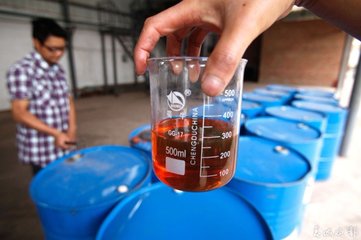
Biodiesel is extracted from plants oil and animal fat, it is commonly used for tractor, truck, ship etc. It refers to oil crops such as soybean, rapeseed, cotton and palm etc., wild oil plants and engineering microalgae and other aquatic plant oils, animal fats, food waste oils etc. as raw material oil, a regenerative diesel fuel that can be produced by transesterification or thermochemical process and can replace petrochemical diesel. Biodiesel is a type of biomass that is physically similar to petrochemical diesel, but has a different chemical composition. Biodiesel is a mixture of complex organic components with extremely high oxygen content. These mixtures are mainly organic substances with large molecular weight, including almost all kinds of oxygenated organic compounds, such as esters, ethers, aldehydes, ketones, phenols, organic acids, alcohols etc. The compound biodiesel is made from wasted plant oils and animal fats, wasted motor oil and by-product of oil refinery, and then added to catalytic, which is synthesized by special equipment and special process.
Brief introduction.
Biodiesel, is a kind of biofuel which is considered to be environmental friendly by using unprocessed plant oils and animal fats and produced through different chemical reaction. The biofuel can be used as diesel. The most commonly producing method of biodiesel is transesterification reaction. Triglyceride, which are the main content of plant oil and fat, reacted with alcohol(generally mathanol) in the presence of catalytic to form a fatty acid ester. The physical and chemical property of fatty acid ester is similar to or better than diesel.
Basic features
Features
- It can reach the standard of European No. 2 emission (GB252-2000)
- The density is smaller than water, and the relative density is between 0.7424 to 0.8886.
- Good stability, long-term preservation and will not deteriorate.
- Excellent environmental features: low sulfur content, low emission of sulfur dioxide and sulfide, biodegradability of biodiesel up to 98%, and the degradation rate is twice that of normal diesel, which can greatly reduce the environment pollution caused by accidental leakage.
- The biodiesel does not contain aromatic alkane that pollute the environment, so the exhaust gas is less harmful to humans than diesel.
- Good low temperature engine start-up performance, no need additives required to cool the filter point to -13℃.
- High cetane number, better combustion performance than diesel, neutral combustion residual to make longer life of engine oil.
- No need to change diesel engine, it can be added to use directly, at the same time no need to add fuel-servicing equipment, storage equipment and special technique training for person.
- The water content is high, and can up to 30% to 45%. Moisture helps to reduce the viscosity of the oil and improve the stability, but reduces the calorific value of the oil.
- Low pH value, so the storage device is preferably an acid corrosion resistant material.
- It has an ‘aging’tendency, heating should not excess 80℃, and it should be protected from light, preserve to avoid contact with air.
- Good safety performance, high flash point, and safe in transportation, storage and use.